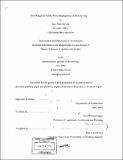Site design for urban water management in Mexico City
Author(s)
Rivera, José Pablo (Rivera De la Mora), 1967-
DownloadFull printable version (11.05Mb)
Other Contributors
Massachusetts Institute of Technology. Dept. of Architecture.
Advisor
Anne Whiston Spirn.
Terms of use
Metadata
Show full item recordAbstract
As the world becomes aware of the scarcity of water resources and cities struggle to meet a growing demand, we face the challenge of finding more efficient ways to manage this vital resource. Cities in developing countries face an even greater challenge as rapid population growth and demographic migration concentrate demand in already exhausted areas. Meeting this deficit has meant the expansion of hydraulic infrastructure to ever distant areas at ever increasing costs. Water supply and disposal in the last decades has been dealt with exclusively by hydraulic engineers. They are once again attracting the interest of architects, landscape architects and planners as the effects of urban development on water resources becomes more evident. In an age of shrinking public budgets, site design can offer a competitive decentralized alternative to the massive engineering projects that would otherwise be needed to meet such demand. This work deals with a set of tools that architects and planners can use to contribute to improving the hydraulic capacity of our cities and to restoring some of the fundamental processes of the natural environment on which they are set. It evaluates their performance in a specific context in Mexico City and explores the feasibility of their application.
Description
Thesis (S.M.)--Massachusetts Institute of Technology, Dept. of Architecture, 2001. Includes bibliographical references (p. 78-80).
Date issued
2001Department
Massachusetts Institute of Technology. Department of ArchitecturePublisher
Massachusetts Institute of Technology
Keywords
Architecture.